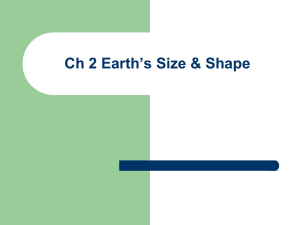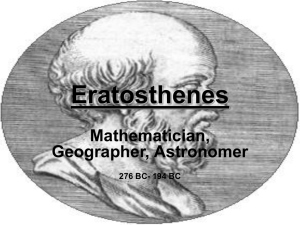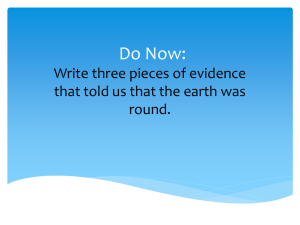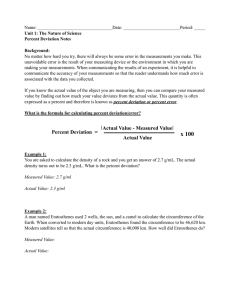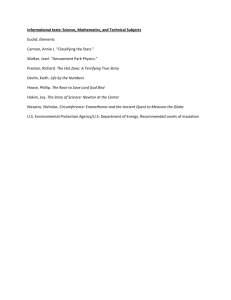AP Physics I - Aledo High School
advertisement
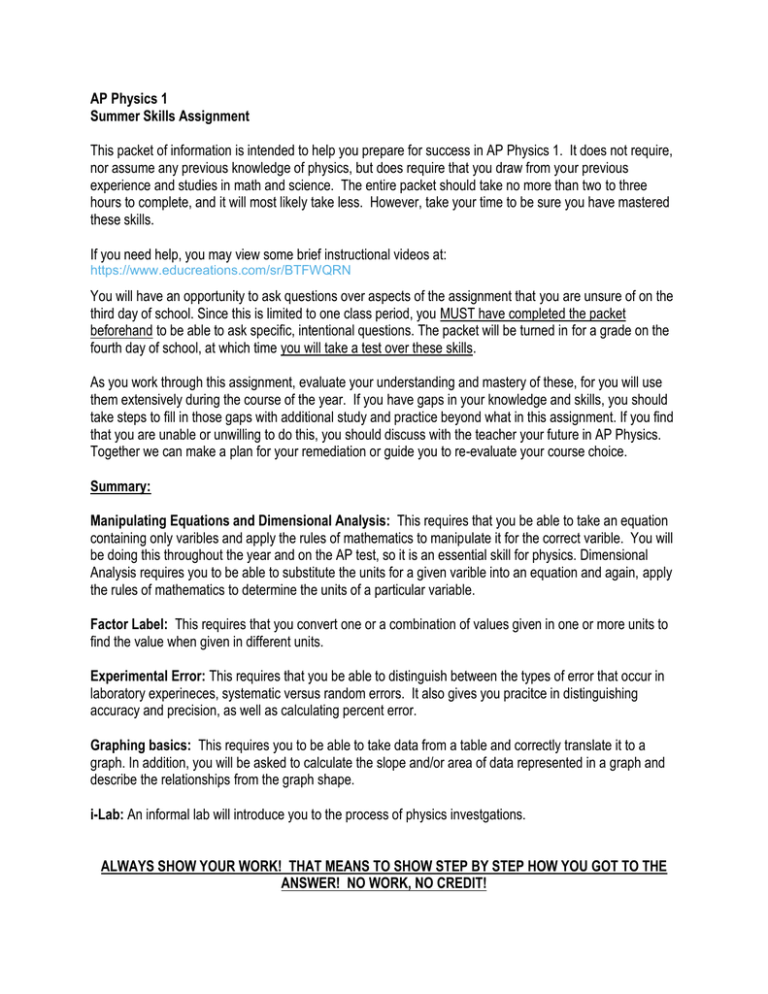
AP Physics 1 Summer Skills Assignment This packet of information is intended to help you prepare for success in AP Physics 1. It does not require, nor assume any previous knowledge of physics, but does require that you draw from your previous experience and studies in math and science. The entire packet should take no more than two to three hours to complete, and it will most likely take less. However, take your time to be sure you have mastered these skills. If you need help, you may view some brief instructional videos at: https://www.educreations.com/sr/BTFWQRN You will have an opportunity to ask questions over aspects of the assignment that you are unsure of on the third day of school. Since this is limited to one class period, you MUST have completed the packet beforehand to be able to ask specific, intentional questions. The packet will be turned in for a grade on the fourth day of school, at which time you will take a test over these skills. As you work through this assignment, evaluate your understanding and mastery of these, for you will use them extensively during the course of the year. If you have gaps in your knowledge and skills, you should take steps to fill in those gaps with additional study and practice beyond what in this assignment. If you find that you are unable or unwilling to do this, you should discuss with the teacher your future in AP Physics. Together we can make a plan for your remediation or guide you to re-evaluate your course choice. Summary: Manipulating Equations and Dimensional Analysis: This requires that you be able to take an equation containing only varibles and apply the rules of mathematics to manipulate it for the correct varible. You will be doing this throughout the year and on the AP test, so it is an essential skill for physics. Dimensional Analysis requires you to be able to substitute the units for a given varible into an equation and again, apply the rules of mathematics to determine the units of a particular variable. Factor Label: This requires that you convert one or a combination of values given in one or more units to find the value when given in different units. Experimental Error: This requires that you be able to distinguish between the types of error that occur in laboratory experineces, systematic versus random errors. It also gives you pracitce in distinguishing accuracy and precision, as well as calculating percent error. Graphing basics: This requires you to be able to take data from a table and correctly translate it to a graph. In addition, you will be asked to calculate the slope and/or area of data represented in a graph and describe the relationships from the graph shape. i-Lab: An informal lab will introduce you to the process of physics investgations. ALWAYS SHOW YOUR WORK! THAT MEANS TO SHOW STEP BY STEP HOW YOU GOT TO THE ANSWER! NO WORK, NO CREDIT! Manipulating Literal Equations: Accuracy and Precision: Accuracy is defined as how close an experimental measurement is to its definitive or actual value. In other words, how “correct” it is. The usual illustration is how close an archer can get his arrows to the bull’s eye. Often times in experimental science we may not know the real, actual value. So the calculated or theoretical value is considered the more accurate value and thus the one we use for comparison.. The other, measured, value is the experimental value. We can then calculate the percent of experimental error using the equation: %Error = (Theoretical – Experimental) / Theoretical When this is a random error, you can usually see it, because the measurement in error appears to have an obvious variance from the other measurements. This is why we usually take three or more measurements. For example: the density of tin is known to be 7.28 g/cm3. When measurements were taken of a material thought to be tin were made, the densities were 7.30, 7.26, 7.82, 7.29, and 7.31. (a) Which of these most likely contains an error? Why? (b) Calculate the percent error for each measurement. Precision is defined as the nearness of measurements to one another, or the consistency of the measurements. Systemic errors usually exhibit precision, but not accuracy. For example, in the above measurements of tin, most of the values, 7.30, 7.26, 7.31, and 7.29 are all precise, and as seen by the error calculation, accurate. This is the ideal. However, had the measurements shown a result of: 8.00, 8.01, and 7.99, the values would show very good precision, but, since the actual value is 7.29, not much accuracy. These types of systematic errors can be due to un-calibrated or wrongly calibrated instruments, or poor procedure by the user. Both need to be eliminated in the procedure. For the sample of data below, tell if they are accurate, precise, both, or neither. Actual value is:8.42 Measurements are: 8.40, 8.62, 8.99, 8.73 _________________________ Actual value is: 2.43 Measurements are: 2.40, 2.41, 2.44 _________________________ Actual value is: 9.81 Measurements are: 9.41, 9.42, 9.39 _________________________ Actual value is: 177.34 Measurements are: 177.35, 177.29, 177.33 _________________________ Actual value is: 16.89 Measurements are: 15.01, 17.92. 16.89 _________________________ GRAPH BASICS: Making graphs: All graphs should have the axes labeled with the property being represented and, in parentheses, the units used to measure it; for example, “Density (g/cm3). The axis upon which the variable is plotted depends on whether it is the dependent or independent variable. The independent variable is the one manipulated during the experiment. You decide what those values will be. The dependent variable is one that is measured in response to the independent variable. This is the value you do not know ahead of time, but are trying to find out. For line graphs, the data points can be used to produce a smooth, straight or curved line. A straight would have a constant slope that can be calculated by: slope = change in y / change in x. As in math class, slope can be either positive or negative. A positive slope shows a direct relationship in which either values increase or decrease together. A negative slope shows an inverse relationship in which one value increases, while the other decreases. A curved line has a changing slope, that is either increasing (getting steeper) or decreasing (getting flatter). Graph the data from the table on the graph provided. Identify the dependent variable and independent variable; tell if the relationship is direct or inverse. a. Independent ____________ c. Calculate the slope:______________ ( + ) or ( - ) b. Dependent _____________ d. Relationship_____________ DATA TABLE: time(s) 0.0 1.0 2.0 3.0 4.0 dist(m) 10.0 8.0 6.0 4.0 2.0 Reading Graphs (looking for relationships) June, ca. 240 B.C. Eratosthenes Measures the Earth By around 500 B.C., most ancient Greeks believed that Earth was round, not flat. But they had no idea how big the planet is until about 240 B.C., when Eratosthenes devised a clever method of estimating its circumference. It was around 500 B.C. that Pythagoras first proposed a spherical Earth, mainly on aesthetic grounds rather than on any physical evidence. Like many Greeks, he believed the sphere was the most perfect shape. Possibly the first to propose a spherical Earth based on actual physical evidence was Aristotle (384-322 B.C.), who listed several arguments for a spherical Earth: ships disappear hull first when they sail over the horizon, Earth casts a round shadow on the moon during a lunar eclipse, and different constellations are visible at different latitudes. Around this time Greek philosophers had begun to believe the world could be explained by natural processes rather than invoking the gods, and early astronomers began making physical measurements, in part to better predict the seasons. The first person to determine the size of Earth was Eratosthenes of Cyrene, who produced a surprisingly good measurement using a simple scheme that combined geometrical calculations with Eratosthenes physical observations. Eratosthenes was born around 276 B.C., which is now Shahhat, Libya. He studied in Athens at the Lyceum. Around 240 B.C., King Ptolemy III of Alexandria appointed him chief librarian of the library of Alexandria. Known as one of the foremost scholars of the time, Eratosthenes produced impressive works in astronomy, mathematics, geography, philosophy, and poetry. His contemporaries gave him the nickname “Beta” because he was very good, though not quite first-rate, in all these areas of scholarship. Eratosthenes was especially proud of his solution to the problem of doubling a cube, and is now well known for developing the sieve of Eratosthenes, a method of finding prime numbers. Eratosthenes’ most famous accomplishment is his measurement of the circumference of Earth. He recorded the details of this measurement in a manuscript that is now lost, but his technique has been described by other Greek historians and writers. Eratosthenes was fascinated with geography and planned to make a map of the entire world. He realized he needed to know the size of Earth. Obviously, one couldn’t walk all the way around to figure it out. Eratosthenes had heard from travelers about a well in Syene (now Aswan, Egypt) with an interesting property: at noon on the summer solstice, which occurs about June 21 every year, the sun illuminated the entire bottom of this well, without casting any shadows, indicating that the sun was directly overhead. Eratosthenes then measured the angle of a shadow cast by a stick at noon on the summer solstice in Alexandria, and found it made an angle of about 7.2 degrees, or about 1/50 of a complete circle. He realized that if he knew the distance from Alexandria to Syene, he could easily calculate the circumference of Earth. But in those days it was extremely difficult to determine distance with any accuracy. Some distances between cities were measured by the time it took a camel caravan to travel from one city to the other. But camels have a tendency to wander and to walk at varying speeds. So Eratosthenes hired bematists, professional surveyors trained to walk with equal length steps. They found that Syene lies about 5000 stadia from Alexandria. Eratosthenes then used this to calculate the circumference of the Earth to be about 250,000 stadia. Modern scholars disagree about the length of the stadium used by Eratosthenes. Values between 500 and about 600 feet have been suggested, putting Eratosthenes’ calculated circumference between about 24,000 miles and about 29,000 miles. The Earth is now known to measure about 24,900 miles around the equator, slightly less around the poles. Eratosthenes had made the assumption that the sun was so far away that its rays were essentially parallel, that Alexandria is due north of Syene, and that Syene is exactly on the tropic of cancer. While not exactly correct, these assumptions are good enough to make a quite accurate measurement using Eratosthenes’ method. His basic method is sound, and is even used by schoolchildren around the world today. Other Greek scholars repeated the feat of measuring the Earth using a procedure similar to Eratosthenes’ method. Several decades after Eratosthenes measurement, Posidonius used the star Canopus as his light source and the cities of Rhodes and Alexandria as his baseline. But because he had an incorrect value for the distance between Rhodes and Alexandria, he came up with a value for Earth’s circumference of about 18,000 miles, nearly 7,000 miles too small. Ptolemy included this smaller value in his treatise on geography in the second century A.D. Later explorers, including Christopher Columbus, believed Ptolemy’s value and became convinced that Earth was small enough to sail around. If Columbus had instead known Eratosthenes larger, and more accurate, value, perhaps he might never have set sail. ©1995 - 2016, AMERICAN PHYSICAL SOCIETY APS encourages the redistribution of the materials included in this newspaper provided that attribution to the source is noted and the materials are not truncated or changed. Editor: Alan Chodos ; Associate Editor: Jennifer Ouellette; Staff Writer: Ernie Tretkoff i-Lab: (Informal Lab) Measuring the speed of the Earth’s rotation To do the following lab, you may need to do some informal research to determine formulas for speed, circumference, etc. Measurements: Get a straight dowel or stake and drive it into the ground far enough that it will remain steady. Measure the length of the shadow from the stake to the top of the shadow. Wait one hour, and then re-measure the length of the shadow. Calculations: Using your knowledge of geometry and the circumference of the Earth, calculate the speed of the Earth’s rotation. Show all of your calculations. We observe: What did you observe as a result of your data collection? Because: Why do you think that happens this way? So that: What predictions could you make regarding the speed of rotation if the earth had a smaller diameter? Error: Given that the actual value for the Earth’s rotation is 1040mph, calculate the per cent error using the equation: [(Actual – experimental) / actual] x 100% Look for sources of error. BUT remember that “inaccurate measurements” and “human error” should be counted as sources of error because each of those is avoidable by being careful and deliberate in doing an experiment. Carelessness is not an acceptable option. Solutions:

